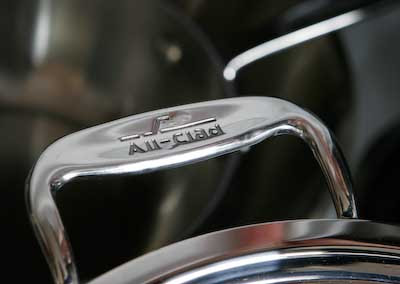Cast-Iron

I heard a salesperson in a cooking store explain to a customer that "iron is a good conductor of heat." That’s true when compared to air or wood, but compared to copper or aluminum, it’s hardly a contender. While iron (cast or otherwise) does not take or conduct heat easily, it does retain it very well. Iron likes whatever temperature it is now and doesn’t easily change. It will eventually give-in and start heating up and, when it does, it's like a big thermal fly-wheel. This is where cast-iron wields its charm.
If you get a thin stainless steel pan nice and hot, then throw a thick steak on it, it'll cool down almost instantly. There just isn't enough mass in the pan to fight back against that big, chilled chunk of protein. Perform the same task with a hefty cast-iron pan, and you'll find the steak will continue to sizzle as the pan gives up heat from its own reserves and takes on new heat from the flames (or coils or magnets) below.
However, all of that powerful momentum comes back to bite you when you want the heat to stop. If your cast-iron pan is too hot, and you need to cool things down a bit, turning off the heat source won't change much for a minute (literally) or two. That pan will continue to give off heat overcooking - or potentially burning - its contents.
I've seen lengthy threads on Chowhound touting the benefits of cooking rather delicate items, such an omelet, on cast-iron. While I’m not saying this isn’t possible, it just shows goes to show that, with enough practice, you can cook anything on just about anything else. Can you do it? Yes. Should you do it? I don’t think so. Temperature control with an omelet is key and cast-iron forces you to think further ahead than you would need to with aluminum or stainless-steel.
Cast-iron also has the problem of being finicky in how it's treated. Can't let it soak in water, can't put it in the dishwasher, and it must be seasoned for the first time before use. This reminds me of my turntable.
A few years ago, I got sentimental about vinyl. I missed the tactile nature of it, how vinyl was almost “alive”; it had to be stored a certain way (or it would warp), handled carefully when removed from the sleeve-within-a-sleeve, the dustcover on the turntable raised, the record placed and immediately cleaned with an expensive cleaning device, and then it was ready to be played. I had forgotten how bad they sounded, like a CD being played through a blanket. The dust, which inevitably remained, was clearly audible.
Turntables and cast iron both have their charms, but for me are best suited to the occasional bouts of sentiment and for specific purposes.

Comments